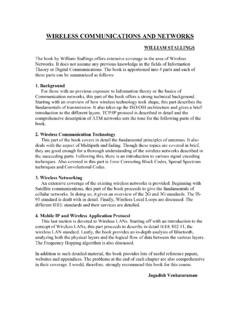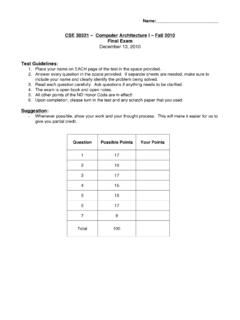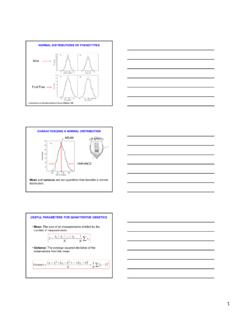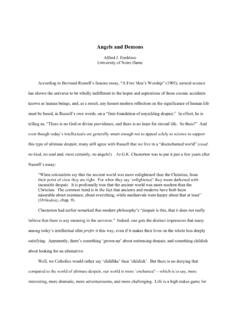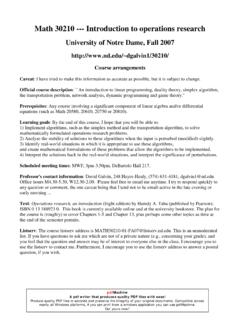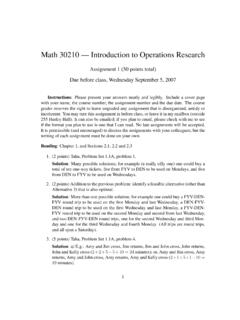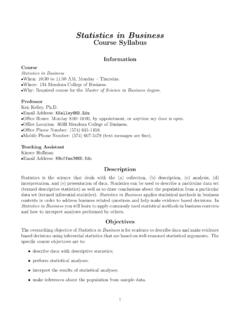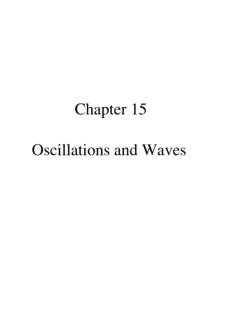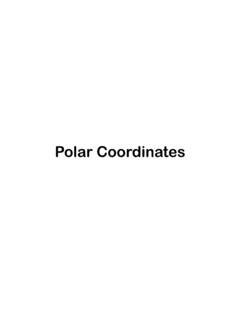Transcription of Lecture 36: Polar Coordinates
1 Polar Co-ordinates Polar to Cartesian Coordinates Cartesian to Polar Coordinates Example 3 Graphing Equations in Polar Coordinates Example 5 Example 5 Example 5 Example 6 Example 6 Using Symmetry Using Symmetry Using Symmetry Example (Symmetry) Circles Tangents to Polar Curves Tangents to Polar Curves Example 9 Polar Co-ordinatesA Polar coordinate system , gives the co-ordinates of a point with reference to apointOand a half line or ray starting at the pointO. We will look at polarcoordinates for points in thexy-plane, using the origin (0,0) and the positivex-axis for pointPin the plane, has Polar Coordinates (r, ), whereris the distance ofthe point from the origin and is the angle that the ray|OP|makes with PilkingtonLecture 36.
2 Polar CoordinatesPolar Co-ordinates Polar to Cartesian Coordinates Cartesian to Polar Coordinates Example 3 Graphing Equations in Polar Coordinates Example 5 Example 5 Example 5 Example 6 Example 6 Using Symmetry Using Symmetry Using Symmetry Example (Symmetry) Circles Tangents to Polar Curves Tangents to Polar Curves Example 9 Example 1 Example 1 Plot the points whose Polar Coordinates are given by(2, 4)(3, 4)(3,7 4)(2,5 2)0 4 23 4 5 43 27 4 23 4 5 43 27 4 23 4 5 43 27 PilkingtonLecture 36: Polar CoordinatesPolar Co-ordinates Polar to Cartesian Coordinates Cartesian to Polar Coordinates Example 3 Graphing Equations in Polar Coordinates Example 5 Example 5 Example 5 Example 6 Example 6 Using Symmetry Using Symmetry Using Symmetry Example (Symmetry) Circles Tangents to Polar Curves Tangents to Polar Curves Example 9 Example 1 Example 1 Plot the points whose Polar Coordinates are given by(2, 4)(3, 4)(3,7 4)(2,5 2)0 4 23 4 5 43 27 4 23 4 5 43 27 4 23 4 5 43 27 PilkingtonLecture 36.
3 Polar CoordinatesPolar Co-ordinates Polar to Cartesian Coordinates Cartesian to Polar Coordinates Example 3 Graphing Equations in Polar Coordinates Example 5 Example 5 Example 5 Example 6 Example 6 Using Symmetry Using Symmetry Using Symmetry Example (Symmetry) Circles Tangents to Polar Curves Tangents to Polar Curves Example 9 Example 1 Note the representation of a point in Polar Coordinates is not unique. Forinstance for any the point (0, ) represents the poleO. We extend themeaning of Polar coordinate to the case whenris negative by agreeing that thetwo points (r, ) and ( r, ) are in the same line throughOand at the samedistance|r|but on opposite side ofO.
4 Thus( r, ) = (r, + )Example 2 Plot the point ( 3,3 4)0 4 23 4 5 43 27 PilkingtonLecture 36: Polar CoordinatesPolar Co-ordinates Polar to Cartesian Coordinates Cartesian to Polar Coordinates Example 3 Graphing Equations in Polar Coordinates Example 5 Example 5 Example 5 Example 6 Example 6 Using Symmetry Using Symmetry Using Symmetry Example (Symmetry) Circles Tangents to Polar Curves Tangents to Polar Curves Example 9 Example 1 Note the representation of a point in Polar Coordinates is not unique. Forinstance for any the point (0, ) represents the poleO. We extend themeaning of Polar coordinate to the case whenris negative by agreeing that thetwo points (r, ) and ( r, ) are in the same line throughOand at the samedistance|r|but on opposite side ofO.
5 Thus( r, ) = (r, + )Example 2 Plot the point ( 3,3 4)0 4 23 4 5 43 27 PilkingtonLecture 36: Polar CoordinatesPolar Co-ordinates Polar to Cartesian Coordinates Cartesian to Polar Coordinates Example 3 Graphing Equations in Polar Coordinates Example 5 Example 5 Example 5 Example 6 Example 6 Using Symmetry Using Symmetry Using Symmetry Example (Symmetry) Circles Tangents to Polar Curves Tangents to Polar Curves Example 9 Polar to Cartesian coordinatesTo convert from Polar to Cartesian Coordinates , we use the identities:x=rcos ,y=rsin Example 3 Convert the following (given in Polar co-ordinates) to Cartesiancoordinates (2, 4) and (3, 3)IIIIIFor (2, 4), we haver= 2, = 4.
6 In Cartesian co-ordinates, we getx=rcos = 2 cos( /4) = 21 2= 2we gety=rsin = 2 sin( /4) = 21 2= 2 IFor (3, 3), we haver= 3, = 3. In Cartesian co-ordinates, we getx=rcos = 3 cos( 3) = 312=32we gety=rsin = 3 sin( 3) = 3 32= 3 32 Annette PilkingtonLecture 36: Polar CoordinatesPolar Co-ordinates Polar to Cartesian Coordinates Cartesian to Polar Coordinates Example 3 Graphing Equations in Polar Coordinates Example 5 Example 5 Example 5 Example 6 Example 6 Using Symmetry Using Symmetry Using Symmetry Example (Symmetry) Circles Tangents to Polar Curves Tangents to Polar Curves Example 9 Polar to Cartesian coordinatesTo convert from Polar to Cartesian Coordinates , we use the identities.
7 X=rcos ,y=rsin Example 3 Convert the following (given in Polar co-ordinates) to Cartesiancoordinates (2, 4) and (3, 3)IFor (2, 4), we haver= 2, = 4. In Cartesian co-ordinates, we getx=rcos = 2 cos( /4) = 21 2= 2we gety=rsin = 2 sin( /4) = 21 2= 2 IFor (3, 3), we haver= 3, = 3. In Cartesian co-ordinates, we getx=rcos = 3 cos( 3) = 312=32we gety=rsin = 3 sin( 3) = 3 32= 3 32 Annette PilkingtonLecture 36: Polar CoordinatesPolar Co-ordinates Polar to Cartesian Coordinates Cartesian to Polar Coordinates Example 3 Graphing Equations in Polar Coordinates Example 5 Example 5 Example 5 Example 6 Example 6 Using Symmetry Using Symmetry Using Symmetry Example (Symmetry) Circles Tangents to Polar Curves Tangents to Polar Curves Example 9 Polar to Cartesian coordinatesTo convert from Polar to Cartesian Coordinates , we use the identities.
8 X=rcos ,y=rsin Example 3 Convert the following (given in Polar co-ordinates) to Cartesiancoordinates (2, 4) and (3, 3)IFor (2, 4), we haver= 2, = 4. In Cartesian co-ordinates, we getx=rcos = 2 cos( /4) = 21 2= 2we gety=rsin = 2 sin( /4) = 21 2= 2 IFor (3, 3), we haver= 3, = 3. In Cartesian co-ordinates, we getx=rcos = 3 cos( 3) = 312=32we gety=rsin = 3 sin( 3) = 3 32= 3 32 Annette PilkingtonLecture 36: Polar CoordinatesPolar Co-ordinates Polar to Cartesian Coordinates Cartesian to Polar Coordinates Example 3 Graphing Equations in Polar Coordinates Example 5 Example 5 Example 5 Example 6 Example 6 Using Symmetry Using Symmetry Using Symmetry Example (Symmetry)
9 Circles Tangents to Polar Curves Tangents to Polar Curves Example 9 Cartesian to Polar coordinatesTo convert from Cartesian to Polar Coordinates , we use the following identitiesr2=x2+y2,tan =yxWhen choosing the value of , we must be careful to consider which quadrantthe point is in, since for any given numbera, there are two angles withtan =a, in the interval 0 2 .Example 3 Give Polar Coordinates for the points (given in Cartesianco-ordinates) (2,2), (1, 3), and ( 1, 3)IFor (2,2), we havex= 2,y= 2. Thereforer2=x2+y2= 4 + 4 = 8, andr= have tan =yx= 2/2 = this point is in the first quadrant, we have = the Polar co-ordinates for the point (2,2) are ( 8, 4).
10 IFor (1, 3), we havex= 1,y= 3. Thereforer2=x2+y2= 1 + 3 = 4, andr= have tan =yx= this point is in the fourth quadrant, we have = the Polar co-ordinates for the point (1, 3) are (2, 3).Annette PilkingtonLecture 36: Polar CoordinatesPolar Co-ordinates Polar to Cartesian Coordinates Cartesian to Polar Coordinates Example 3 Graphing Equations in Polar Coordinates Example 5 Example 5 Example 5 Example 6 Example 6 Using Symmetry Using Symmetry Using Symmetry Example (Symmetry) Circles Tangents to Polar Curves Tangents to Polar Curves Example 9 Cartesian to Polar coordinatesTo convert from Cartesian to Polar Coordinates , we use the following identitiesr2=x2+y2,tan =yxWhen choosing the value of , we must be careful to consider which quadrantthe point is in, since for any given numbera, there are two angles withtan =a, in the interval 0 2.
